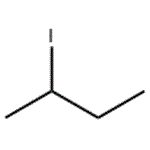It is used as a solvent organic synthesis and as pharmaceutical intermediate.
2-iodobutane is a colorless liquid. Less dense than water. Vapors heavier than air. Used to make other chemicals and as a solvent.
Highly flammable. Slightly soluble in water.
Halogenated aliphatic compounds, such as 2-Iodobutane, are moderately or very reactive. Reactivity generally decreases with increased degree of substitution of halogen for hydrogen atoms. Low molecular weight haloalkanes are highly flammable and can react with some metals to form dangerous products. Materials in this group are incompatible with strong oxidizing and reducing agents. Also, they are incompatible with many amines, nitrides, azo/diazo compounds, alkali metals, and epoxides.
May cause toxic effects if inhaled or absorbed through skin. Inhalation or contact with material may irritate or burn skin and eyes. Fire will produce irritating, corrosive and/or toxic gases. Vapors may cause dizziness or suffocation. Runoff from fire control or dilution water may cause pollution.
HIGHLY FLAMMABLE: Will be easily ignited by heat, sparks or flames. Vapors may form explosive mixtures with air. Vapors may travel to source of ignition and flash back. Most vapors are heavier than air. They will spread along ground and collect in low or confined areas (sewers, basements, tanks). Vapor explosion hazard indoors, outdoors or in sewers. Runoff to sewer may create fire or explosion hazard. Containers may explode when heated. Many liquids are lighter than water.
Purify the iodide by shaking with conc H2SO4, then washing it with water, aqueous Na2SO3 and again with water. Dry (MgSO4) and distil. Alternatively, pass it through a column of activated alumina before distillation, or treat with bromine, followed by extraction of the free halogen with aqueous Na2S2O3, thoroughly washing with water, drying and distilling. It is stored over silver powder and distilled before use. [Beilstein 1 IV 272.]


